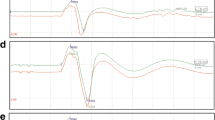Abstract
The efficacy of transcranial myogenic motor-evoked potential (tc-MEP) monitoring during thoracic aortic surgery has been the subject of some reports, because tc-MEP monitoring can rapidly reflect changes in spinal cord blood flow during thoracic aortic cross-clamping. In this article, we present a case in which delayed loss of tc-MEP signals was observed after cross-clamping of the descending thoracic aorta. We must be aware that tc-MEPs recorded from the lower extremities can fail to provide rapid detection of spinal cord ischemia in the upper thoracic level after cross-clamping of the descending thoracic aorta.
Similar content being viewed by others
References
Svensson LG, Crawford ES, Hess KR, Coselli JS, Safi HJ. Experience with 1509 patients undergoing thoracoabdominal aortic operations. J Vasc Surg. 1993;17:357–368.
Meylaerts SA, Jacobs MJ, van Iterson V, de Haan P, Kalkman CJ. Comparison of transcranial motor evoked potentials and somatosensory evoked potentials during thoracoabdominal aortic aneurysm repair. Ann Surg. 1999;230:742–749.
de Haan P, Kalkman CJ, De Mol BA, Ubags LH, Veldman DJ, Jacobs MJ. Efficacy of transcranial motor-evoked myogenic potentials to detect spinal cord ischemia during operations for thoracoabdominal aneurysms. J Thorac Cardiovasc Surg. 1997;113:87–100.
Kakinohana M, Kawabata T, Miyata Y, Sugahara K. Myogenic transcranial motor evoked potentials monitoring cannot always predict neurological outcome after spinal cord ischemia in rats. J Thorac Cardiovasc Surg. 2005;129:46–52.
Kakinohana M, Nakamura S, Fuchigami T, Miyata Y, Sugahara K. Influence of the descending thoracic aortic cross clamping on bispectral index value and plasma propofol concentration in humans. Anesthesiology. 2006;104:939–943.
Machida M, Weinstein SL, Yamada T, Kimura J, Toriyama S. Dissociation of muscle action potentials and spinal somatosensory evoked potentials after ischemic damage of spinal cord. Spine. 1988;13:1119–1124.
Gharagozloo F, Neville RF Jr, Cox JL. Spinal cord protection during surgical procedures on the descending thoracic and thoracoabdominal aorta: a critical overview. Semin Thorac Cardiovasc Surg. 1998;10:73–86.
Elger CE, Speckmann EJ, Caspers H, Janzen RWC. Corticospinal connections in the rat. I. Monosynaptic and polysynaptic responses of cervical motorneurons to epicortical stimulation. Exp Brain Res. 1977;28:385–404.
Fehlings MG, Tator CH, Dean Linden R, Riper IR. Motor evoked potentials recorded from normal and spinal cord-injured rats. Neurosurgery. 1987;20:125–130.
Ryder J, Zappulla R, Nieves J. Motor evoked potentials elicited from pyramidal stimulation and recorded from the spinal cord in the rat. Neurosurgery. 1991;28:550–558.
de Haan P, Kalkman CJ. Spinal cord monitoring: somatosensory-and motor-evoked potentials. Anesthesiol Clin North America. 2001;19:923–945.
Brown RH, Nash CL, Berilla JA, Amaddio MD. Cortical evoked potential monitoring: a system for intraoperative monitoring of spinal cord function. Spine. 1984;9:256–261.
Lips J, de Haan P, de Jager SW, Vanicky I, Jacobs MJ, Kalkman CJ. The role of transcranial motor evoked potentials in predicting neurologic and histopathologic outcome after experimental spinal cord ischemia. Anesthesiology. 2002;97:183–191.
Urban M. Spinal cord ischemia. Recognition and prevention. In: Black TJJ, editor. Neuroprotection. Baltimore: Williams & Wilkins; 1997. p. 135–162.
Charagozloo F, Larson J, Dausmann MJ, Neville RF Jr, Gomes MN. Spinal cord protection during surgical procedures on the descending thoracic and thoracoabdominal aorta: review of current techniques. Chest. 1997;109:799–809.
Domisse GF. The blood supply of the spinal cord: a critical vascular zone in spinal surgery. J Bone Joint Surg. 1974;56B:225–235.
Miyairi T, Kotsuka Y, Morota T, Kubota H, Shibata K, Ikeda Y, et al. Paraplegia after open surgery using endovascular stent graft for aortic arch aneurysm. J Thorac Cardiovasc Surg. 2001;121:1240–1243.
Crawford ES, Crawford JL, Safi HJ, Coselli JS, Hess KR, Brooks B, Norton HJ, Glaeser DH. Thoracoabdominal aortic aneurysms: preoperative and intraoperative factors determining immediate and long-term results of operations in 605 patients. J Vasc Surg. 1986;3:389–404.
Konard PE, Tacker WA, Levy WJ, Reedy DP, Cook JR, Greddes LA. Motor evoked potentials in dog: effects of global ischemia on spinal cord and peripheral nerve signals. Neurosurgery. 1987;20:117–124.
Lips J, de Haan P, Bouma GJ, Jacobs MJ, Kalkman CJ. Delayed detection of motor pathway dysfunction after selective reduction of thoracic spinal cord blood flow in pigs. J Thorac Cardiovasc Surg. 2002;123:531–538.
Author information
Authors and Affiliations
About this article
Cite this article
Kakinohana, M., Abe, M., Miyata, Y. et al. Delayed response of transcranial myogenic motor-evoked potential monitoring to spinal cord ischemia during repair surgery for descending thoracic aortic aneurysm. J Anesth 22, 304–307 (2008). https://doi.org/10.1007/s00540-008-0633-3
Received:
Accepted:
Published:
Issue Date:
DOI: https://doi.org/10.1007/s00540-008-0633-3




